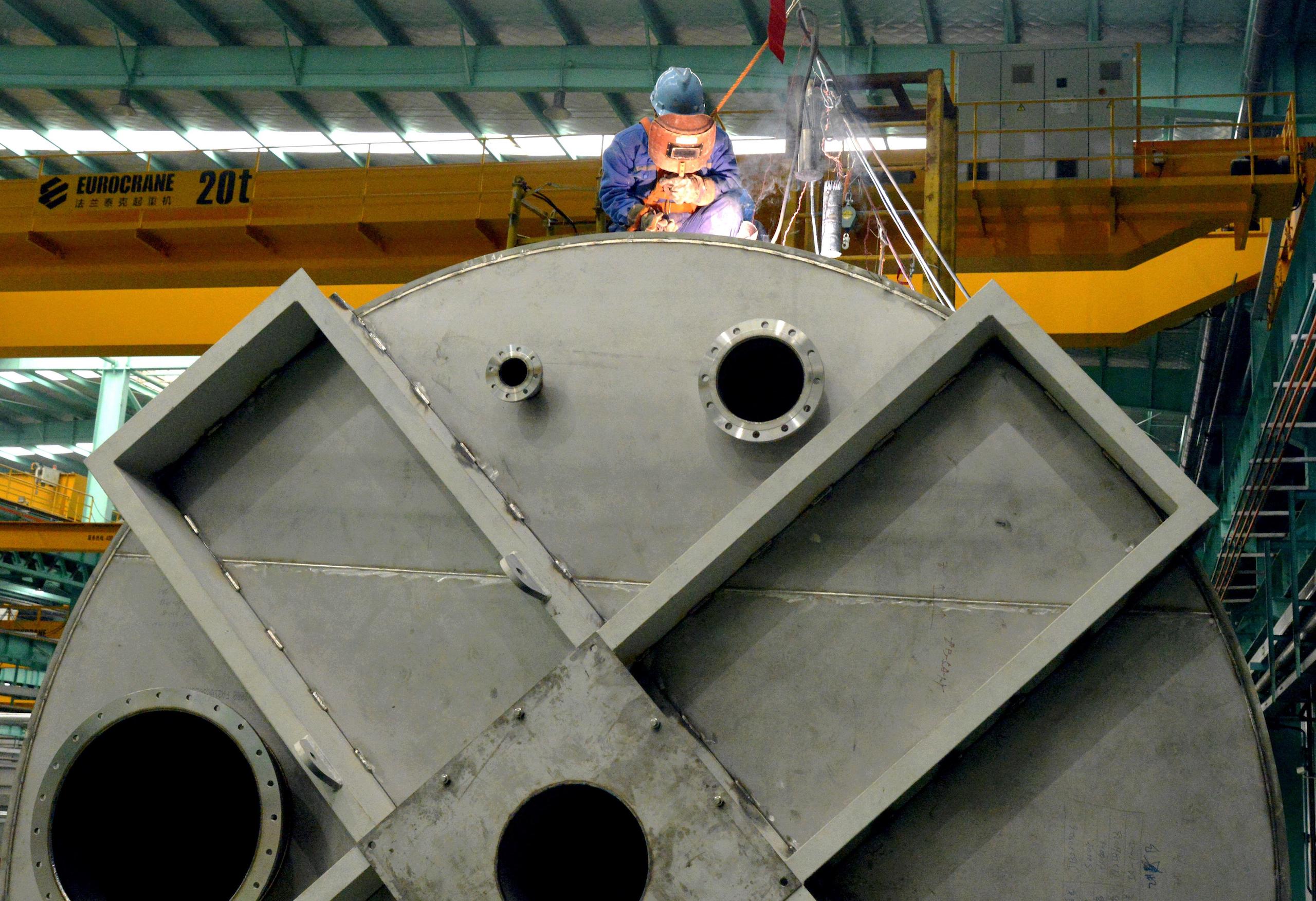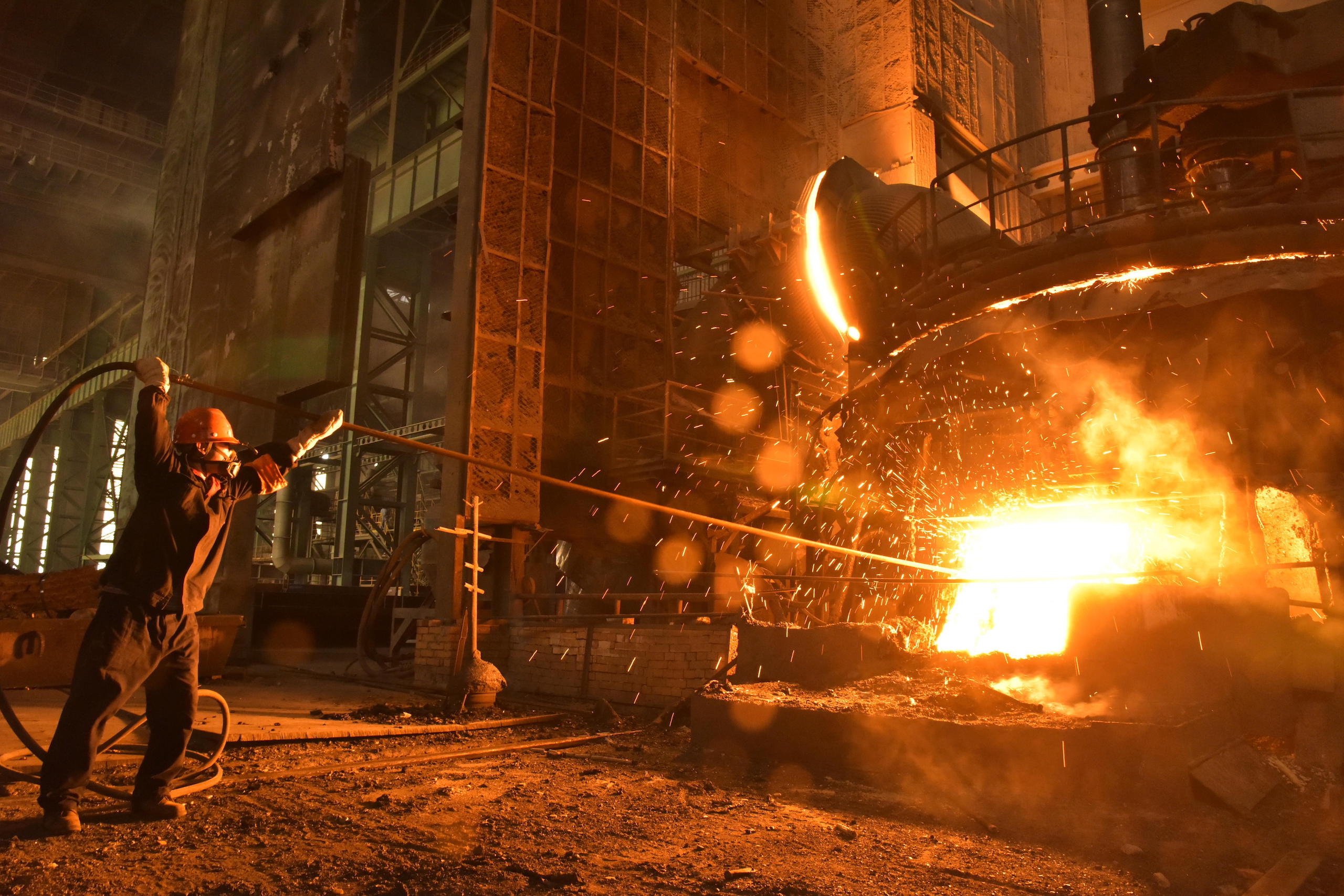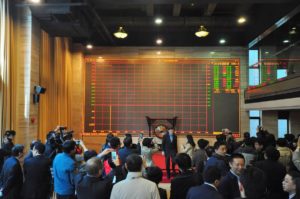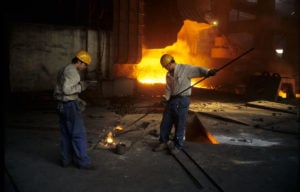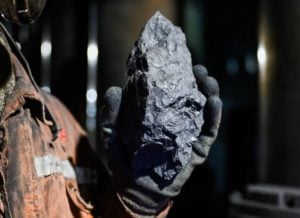China’s national carbon market has been trading for two years. At present, the market only covers China’s power sector, but the plan is for it to steadily expand, embracing other emissions-intensive industries, such as steel, non-ferrous metals and building materials.
The steel industry accounts for about 15% of China’s carbon emissions, making it the largest carbon emitter among the manufacturing industries. Bringing it into the national carbon market and using carbon costs to force firms into adopting lower-carbon production processes, would be a significant development for China’s low-carbon transition.
With the planned entry into force of the EU’s Carbon Border Adjustment Mechanism (CBAM) – the imposition of a carbon levy on certain emission-intensive products from outside the bloc – Chinese steelmakers are increasingly concerned about the extra costs they will face when exporting to the EU due to a lack of domestic carbon pricing. It is widely held within the industry that extending the coverage of the carbon market would be the main way to deal with this.
Given China’s overarching climate targets – peaking emissions before 2030 and reaching net zero before 2060 – and the new direction in international trade, it appears inevitable that the steel industry will be brought into the national carbon market. The main issue now is when that will happen, and in what form?
Inclusion expected by the end of 2025
The allocation of “allowances” in the national carbon market depends on accurate corporate carbon emissions data, which means more requirements in terms of emissions data.
What are emissions allowances?
These give companies the right to emit a certain amount of CO2 and are calculated based on emissions intensity, meaning the volume of emissions per unit of output.
If a company emits more CO2 than their allocated allowances cover, it must buy more allowances on the market.
The power sector’s robust data infrastructure was one of the main reasons it was the first industry to be brought into the national carbon market. In the steel industry, however, carbon accounting boundaries, workflows, and the characteristics of energy consumption are more complex. Establishing the underlying data for carbon trading is a drawn-out process.
In recent years, government departments have issued various notices and requirements aimed at improving the underlying data on carbon emissions from steel. In 2021, the Ministry of Ecology and Environment (MEE) commissioned the China Iron and Steel Association to draw up an allowance-allocation programme for the sector and undertake a study into the existing system for monitoring, reporting and verification (MRV) of carbon emissions. In 2022, MEE issued the “Notice on doing key work relating to the management of corporate greenhouse gas emission reports in 2022”, requiring the submission and verification of 2021 greenhouse gas emissions reports from firms in industries other than the power sector, including petrochemicals, building materials, iron and steel, non-ferrous metals, paper-making and aviation.
The main workflows in steelmaking include ore mixing, sintering, pelletising, iron smelting, steelmaking, and steel rolling. To date, six major production processes – those for coking, sintering, pelletising, blast furnace iron smelting, converter steelmaking, and electric furnace steelmaking – have been brought into the national carbon market’s MRV system, and this is driving steady improvement in the industry’s data infrastructure.
In June, the Chinese Academy for Environmental Planning held its first and second working meetings for a project on bringing the steel industry into the national carbon market. The meetings gathered governing authorities, industry associations, research institutes, and third-party verification organisations to discuss key issues such as carbon accounting boundaries in the sector, allocation of allowances for different steel production processes, and monitoring reports. What emerged was a proposal to complete the initial work of bringing the steel industry into the national carbon market by speedily confirming the main production processes for which carbon allowances can be allocated, along with the benchmarks for allocations and the methodology for emissions verification.
Judging by the direction followed by governmental departments in recent years, and the views of sectoral experts, the implementation programme for allocating carbon allowances in the steel industry is expected to be completed towards the end of the 14th Five Year Plan period (2021–2025). Steel will then be part of the second batch of key emitting industries, after the power sector, to be brought into the national carbon market. The coming into force of the CBAM will have a clear impact on China’s steel exports and may also hasten the industry’s integration into the national carbon market, to avoid the additional carbon costs associated with a lack of domestic carbon pricing.
Expected adoption of benchmarking for allocating allowances
Once a company joins the carbon market, it is given a soft limit (as opposed to a hard cap) on CO2 emissions intensity over a particular period. This limit amount is its “carbon allowance”. Carbon allowances are approved and allocated by government authorities, and in order to comply with the scheme firms must annually write off an amount of carbon allowance equivalent to their own carbon emissions. The allocating of carbon allowances is key to the overall set-up of the carbon market, and it is yet to be finalised how allocations will be carried out in the steel industry after incorporation into the national carbon market.
There are two main methods for allocating carbon allowances in the steel industry: grandfathering and benchmarking.
Using grandfathering, carbon allowances are set according to a company’s historical carbon intensity or total carbon emissions. This can be viewed as a way of comparing the company with its own track record.
Using benchmarking, allowances are approved according to the industry’s benchmarked carbon intensity, which amounts to making a horizontal comparison among companies. The benchmark value is an average of the carbon intensity among firms in the top percentiles; in the EU carbon market, for example, the benchmark is set according to the performance of firms in the top 10% for productivity.
Carbon markets outside of China mainly use benchmarks for allocating carbon allowances in the steel sector. In the EU, this method is used to set carbon intensity benchmarks for free allowances covering six major steel production processes and products. However, benchmarking makes more requirements in terms of data, so in China’s trial carbon markets it is the grandfathering approach that prevails.
The steel industry is already included in six of the eight regional carbon markets being piloted in China – those in Tianjin, Hubei, Shanghai, Fujian, Chongqing and Guangdong. Five of them have adopted grandfathering, with only Guangdong using an approach that combines benchmarking for different steel-making processes with grandfathering.
A significant shortcoming in the design of the grandfathering method is that it does not incentivise firms with outdated processes to improve their efficiency and emissions reduction. Companies that have previously achieved sizeable emission reductions and are more energy efficient receive fewer carbon allowances, because of their low historical emissions, whereas those with high carbon intensity and outdated processes benefit from relatively generous carbon allowance caps. Benchmarking, by contrast, tends to supply carbon allowances to the more technologically advanced companies, putting the onus on firms with low- to medium-level energy efficiency and incentivising them to rise above industry benchmarks. This is because the emissions generated by low-carbon-intensity firms are actually lower than the allowances they receive by benchmarking, while high-carbon-intensity firms produce more emissions than the allowances they receive.
The foundations for a benchmarking approach for the steel sector, in China’s carbon market, are gradually firming up. For one thing, large steel producers such as Baosteel, WISCO and Shougang are covered by China’s pilot carbon markets, and have built up experience during the market’s first few years. Also, steelmakers with annual greenhouse gas emissions of 26,000 tonnes of CO2 equivalent and above have begun reporting their carbon emissions and related data to MEE, so the underlying data is increasingly robust.
China’s national carbon market currently uses benchmarking for allocation of carbon allowances in the power industry. Determining benchmarks for industries soon to join the national carbon market is therefore an important, fundamental component of developing the national carbon market. At the second working meeting of the project for bringing the steel industry into the national carbon market, held in June, it was agreed that benchmarks for allocation of carbon allowances in the steel industry should be determined as soon as possible. In addition, the benchmark for steel products covered by the EU’s CBAM is based on the carbon intensity benchmark for free allowances set in the EU carbon market. Bearing in mind the requirement to meet Europe’s CBAM requirements, it is more likely that benchmarking will be adopted for allocating carbon allowances in the steel industry, once it becomes part of the national carbon market.
Carbon market forces steel firms to transform
China’s steel industry currently accounts for 5% of national GDP, and its output is more than half of the world total. However, unlike the short-process steelmaking in the EU and elsewhere, which predominately uses recycled scrap, over 90% of steel production in China is long-process steelmaking from iron ore. According to statistics from the World Steel Association, long-process production accounted for 90% of China’s crude steel output in 2019, and short-process 10%; outside of China, the proportions were 52% long-process and 48% short-process.
Low production costs and high carbon intensity are a feature of long-process flows based on coal and coke. For emissions-reduction in the steel industry, full consideration needs to be given to measures for improving energy efficiency, modifying the industrial structure and reducing pollution and carbon emissions, along with rational use of the carbon market mechanism.
The “Interim regulations on administration of carbon trading (draft revision)” propose that carbon allowances should “initially be allocated free of charge, in the main, with paid allocation introduced at an appropriate time in accordance with national requirements, and the proportion of paid allocation to steadily expand.” Firms will bid for paid allocations on the market, and as the share of paid allocations rises so will the pressure on the firms to be compliant.
As the supply of free allowances tightens, firms that are doing well in terms of emissions reduction can sell their unused allowances and apply the proceeds to technological innovation and optimisation of their production processes, resulting in a virtuous cycle of low-carbon transformation. Firms with low efficiency and poor emissions-reduction performance, on the other hand, will have to buy additional allowances in order to operate and be compliant. This will force them to speed up their own low-carbon transition, including the adoption of lower-carbon short-flow processes, if they are to avoid further loss of competitiveness due to rising costs.
However, there is expected to be little impact on production costs for steelmakers in the initial stage of their industry’s incorporation into the national carbon market, with allowances being issued free for the most part. A mechanism for issuing carbon allowances by auction can gradually be introduced to the national carbon market, raising the proportion of paid allocations in the steel sector, with the returns used to help firms reduce their greenhouse gas emissions and build up the carbon market. Moreover, if industry benchmarking is used to allocate carbon allowances to steelmakers, it should further improve the data infrastructure for carbon trading, including the setting of clear rules for monitoring greenhouse gas emissions, periodic auditing of firms’ emissions reports, and strengthening of verification by third parties to ensure that benchmarking supports data that are accurate and reliable.
